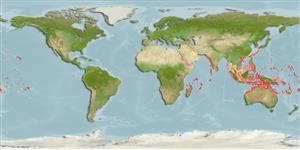Common names from other countries
分类 / Names
俗名 | 同种异名 | Catalog of Fishes(属, 种) | ITIS | CoL | WoRMS | Cloffa
Environment: milieu / climate zone / depth range / distribution range
生态学
海洋 礁区鱼类; 深度上下限 30 - 50 m (Ref. 1602). 热带; 32°N - 24°S, 30°E - 145°W
Indo-Pacific: Red Sea to East Africa, through northern Australia to Society Islands, north to southern Japan.
印度-太平洋: 红海南至南非的德尔班 (参考文献 4420) 而且东至社会群岛, 北至日本南部, 南至澳洲大堡礁的南方与新加勒多尼亚。 罕见在太平洋.(参考文献 9710)
大小 / 重量 / 年龄
Maturity: Lm ? range ? - ? cm
Max length : 55.0 cm TL 雄鱼/尚未辨别雌雄; (Ref. 9770)
背棘 (总数) : 3; 背的软条 (总数) : 24 - 27; 臀棘: 0; 臀鳍软条: 19 - 24. Dark brown, scales with yellow spot; pectoral, soft dorsal, anal and caudal fins dark with yellow margins; juveniles yellowish brown with bluish grey spots and blotches (Ref. 4420). Juveniles under about 5 cm, tan with dark saddles and numerous dark wavy lines on the body. Larger juveniles loose the dark saddles and become covered in a network of brilliant blue lines which become increasingly interconnected with growth (Ref. 37816).
深褐色的, 鳞片有黄斑; 胸鳍, 软的背鳍、臀鳍与尾鳍深色且有黄色的边缘; 稚鱼土黄色有蓝灰色的斑点与斑块。 (参考文献 4420) 在大约 5 公分下面的稚鱼, 黄褐色的在身体上有深色的鞍状斑与很多的深色波浪状的线。 较大的稚鱼释放深色的鞍状斑而且在逐渐地变成随着成长互相连接的一个色彩艳丽蓝色的线网络变成隐蔽着。 (参考文献 37816)
Occur in clear shallow lagoons and seaward reefs; sandy areas near reef patches of reef edge are preferred. Adults on deep reefs or with shipwrecks, usually deeper than 30 meters. Juveniles inshore on rubble reef or small outcrops on open substrate (Ref. 48637). Feed on sea urchins, crustaceans, mollusks, dead fish, tunicates or corals (Ref. 5503). Oviparous (Ref. 205). Monogamous (Ref. 52884). Also caught with drive-in nets. Marketed fresh and dried-salted (Ref. 9770).
出现在清澈的舄湖浅滩与临海礁石; 在礁边缘的礁区块附近的沙地被偏爱。 成鱼在深的礁上或具有遇难船, 通常深度超过 30 公尺。 在开放性的底层上稚鱼在沿海地区的碎石礁或小的露头。 (参考文献 48637) 捕食海胆,甲壳动物,软件动物,死的鱼,被囊类或珊瑚。 (参考文献 5503) 卵生的.(参考文献 205) 一夫一妻的.(参考文献 52884) 也用围网捕获。 在市场上销售生鲜或干渍了。 (参考文献 9770)
Life cycle and mating behavior
Maturities | 繁殖 | Spawnings | Egg(s) | Fecundities | 仔鱼
Distinct pairing (Ref. 205). Nest-guarding females are aggressive (Ref. 9770). Females are territorial, solely tending and guarding the eggs. Males exhibit polygyny (Ref. 116451).印度-太平洋: 红海南至南非的德尔班 (参考文献 4420) 而且东至社会群岛, 北至日本南部, 南至澳洲大堡礁的南方与新加勒多尼亚。 罕见在太平洋.(参考文献 9710)
Myers, R.F., 1991. Micronesian reef fishes. Second Ed. Coral Graphics, Barrigada, Guam. 298 p. (Ref. 1602)
CITES (Ref. 128078)
Not Evaluated
人类利用
渔业: 商业性; 水族馆: 商业性
工具
特别资料
下载 XML
网络资源
Estimates based on models
Preferred temperature (Ref.
115969): 24.7 - 28.4, mean 27.5 (based on 138 cells).
Phylogenetic diversity index (Ref.
82804): PD
50 = 0.6250 [Uniqueness, from 0.5 = low to 2.0 = high].
Bayesian length-weight: a=0.03548 (0.02074 - 0.06071), b=2.94 (2.79 - 3.09), in cm Total Length, based on LWR estimates for this species & (Sub)family-body (Ref.
93245).
营养阶层 (Ref.
69278): 4.0 ±0.0 se; based on diet studies.
回复力 (Ref.
120179): 中等的, 族群倍增时间最少 1.4 - 4.4年 (Preliminary K or Fecundity.).
Fishing Vulnerability (Ref.
59153): Moderate vulnerability (42 of 100).
